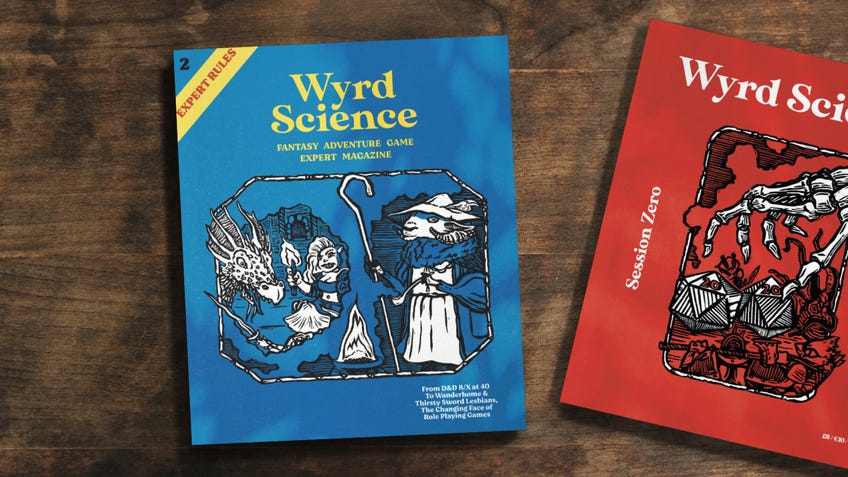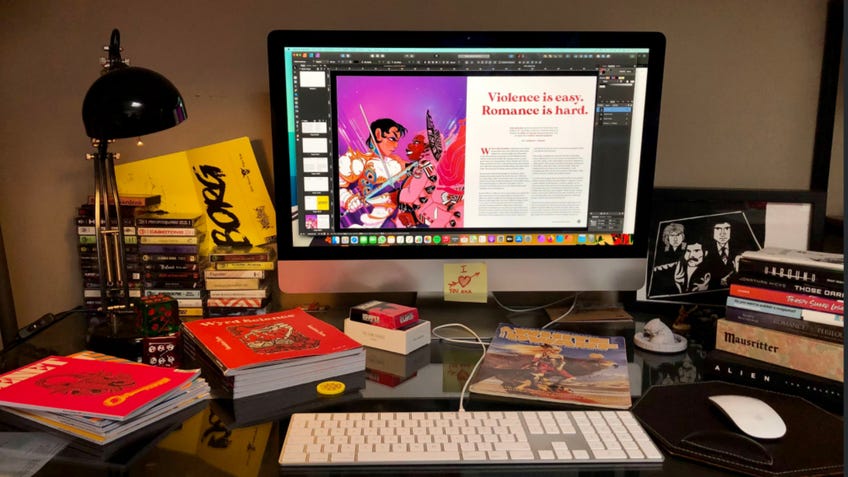Not some kind of Grognard Tribune: the creator of Wyrd Science talks creating an TTRPG magazine for all.
“Games are changing, and those people are bringing so much good stuff to the table."
It started with a few drinks at lunch followed by indulging nostalgia with a box of Warhammer skeleton miniatures from a local Games Workshop outlet. John Power - writer, editor and music PR manager - hadn’t meant to fall back into the hobby he’d set aside decades earlier.
Over the next four years that one box multiplied and was soon joined by RPG sourcebooks, adventures and zines that Power found both “radically different and comfortingly familiar”. They was cutting sprues, mixing paints and poring over lovingly bound art games during every spare moment.
“But at the same time I started to get a bit frustrated. It felt like games had moved on, but the media either hadn’t or just didn’t exist,” Power told Dicebreaker in an interview.
Between the rules and mechanics-focused blogs and the system specificity of magazines like White Dwarf and Dragon, Power felt like the hobby could use something closer to what he was familiar with working in the music industry - “not sitting there breaking down the chords of a song but more telling the story behind it, the stories behind the people who made the games and played them,” they said.
The answer would eventually come in the form of Wyrd Science, a magazine funded through Kickstarter that gathered contributed articles, artwork, musings and thoughts into a physically bound edition that endeavored to treat the hobby with love and curiosity.
It would be easy to say that the COVID-19 pandemic paved the way for Wyrd Science, but Power admits the first few months were spent in a familiar sounding busy haze of distractions and restlessness.
“I was just doing a ridiculous amount of running and sitting in the forest by our house trying to figure out what to do with my life but then suddenly summer was over and I had this horrible realisation that things might go back to some kind of normal soon and I didn’t even have a home baked sourdough loaf to show for it,” they said.

Power drew on a lifetime writing for a living, even if it only paid beer money at times. Their freelance stints in the London music scene evolved into a record label PR position. They don’t remember that time fondly - “writing all the press releases, dealing with journalists and then at night writing for all these soon-to-be-defunct websites” - but the experience in editing and layout found new purpose as they began gathering folks who also felt the tabletop hobby could benefit from a boutique magazine.
The Kickstarter campaign funding the first issue - blithely called "Session Zero" - managed to raise £5,500 of its £1,000 goal. It promised a “quarterly magazine celebrating roleplaying games, war-games and board games that sets out to give space wizards, gelatinous cubes and tentacled gods the respect they deserve.” Inside were interviews with comics writer and lifelong tabletop fan Kieron Gillen, Tales from the Loop creator Simon Stålenhag and Jiangshi: Blood in the Banquet Hall designer Banana Chan. It spotlighted indie resources, podcasts and publishers as well as talking shop and pondering on how and why people play games.
“I want to give game designers the space to really break out their ideas, talk about what’s influenced or inspired them beyond just the mechanics of games,” Power said. They believe in situating tabletop games not only within their history so that players can build an institutional knowledge - both good and bad - but also among the culture and politics that gave them form.
“Games are changing. Who makes them and who plays them is wildly different, or at least visibly different, now than it was 10, 20, or 40 years ago. And those people are bringing so much good stuff to the table it should be celebrated.
The initial printing of 500 sold out within 10 days and is currently on its third run for retail, apparently costing them about 10p per copy, but they would rather put the magazine in as many hands as possible than turn a buck. In fact, Power claimed at the outset of this project that the first three issues would allow for mess, experimentation in form and the space to discover what Wyrd Science should look like going forward.
Enter issue two, finishing up its Kickstarter campaign at time of writing. The goal had been raised to £4,000, and is currently sitting at nearly triple that amount. The public obviously responded well to their mission. Clocking in at a larger 112 pages - “a testament to my inability as an editor to say no, I guess,” Power admitted - the second issue will feature a dedicated news section, more reviews and a slight change in how it approaches features.

“One of the things I love about print magazines is that they can open you up to things you might not otherwise read about,” they said. “Online is so click driven that every story has to justify its existence via views and people tend to just click in and out on things that particularly appeal to them.”
In comparison, Power believes Wyrd Science offers plenty of reasons to read it from front to back, such as the cover celebrating the 40th anniversary of Dungeons & Dragons Basic/Expert followed immediately by a feature on Thirsty Sword Lesbians. They print voices from the RPGLatAm and RPGSEA movements, both non-Westerns scenes proving they have much for players to anticipate. It’s evident they trust in their writers, artists, editors and perhaps even the inherent joy of print media to justify the breadth of coverage.
The success of issue two’s crowdfunding means Power is ready to push immediately into planning for the third, due out just before Halloween this year. 2022 is less set in stone - the current plan is to review the work and reception to the initial trio of magazines and “expand the brand, if you’ll forgive my marketing speak,” they said. They’re hesitant to say whether that’s podcasts, videos or other printed material at this time, but the metaphorical creative engine seems to have plenty of fuel to burn.


